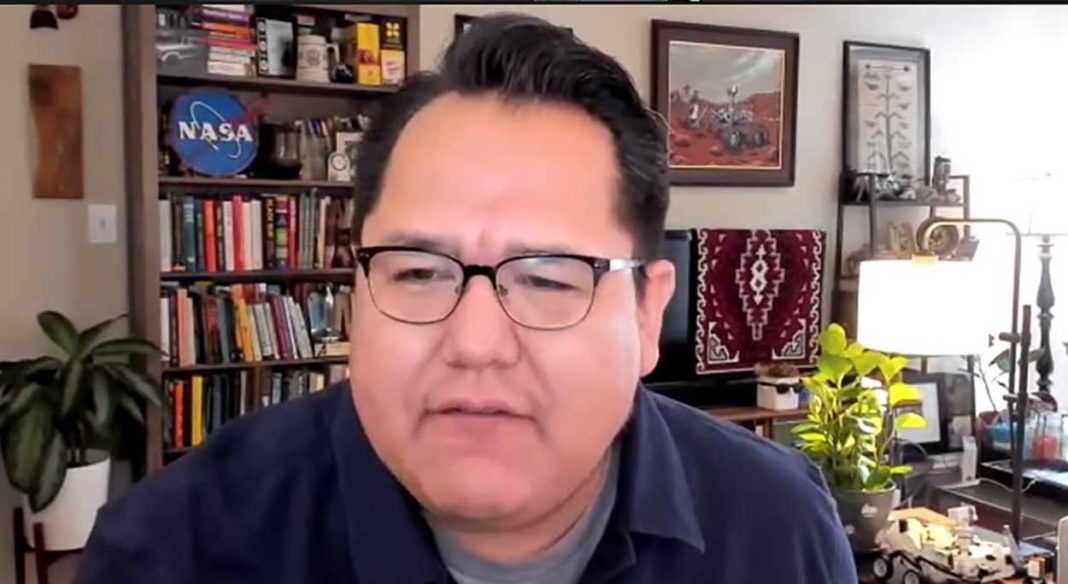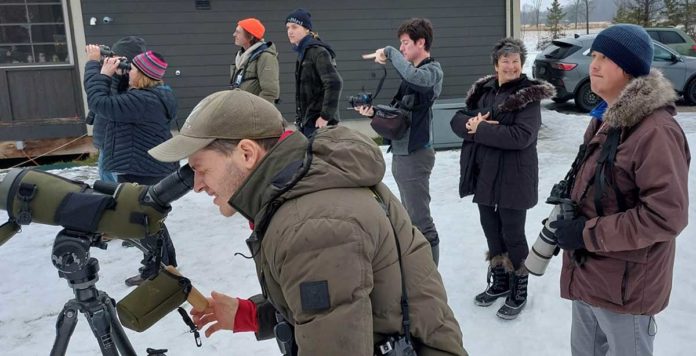WIIKWEMKOONG—Navajo NASA Jet Propulsion Laboratory mechanical engineer Aaron Yazzie was born in Tuba City, Arizona, a small town in the Navajo Nation, but he grew up in nearby Holbrook where he went to school. Last week, Mr. Yazzie dropped in to Wiikwemkoong High School via Zoom to meet with that school’s robotics team members for a Q and A session. Wiikwemkoong Board of Education (WBE) communications officer Dwayne Animikwan credited former WBE education director Dominic Beaudry, “an outstanding member of our community,” with initially setting the ball in motion for the session.
“I am excited and privileged to be here today,” said Mr. Yazzie, who went on to provide a traditional greeting that mirrors those of the Anishinaabe, noting his parentage and where he comes from. He shared that his grandparents instilled the importance of letting people know who he is when first introduced.
Mr. Yazzie went on to speak of his childhood and developing years, describing himself as something of a “math nerd” while attending school, noting that while other schoolmates were pictured in the school yearbook playing soccer or other activities, he was pictured pouring over his math text. “The caption would say ‘here is so-and-so doing soccer,’ ‘here is so-and-so on stage,’ ‘here is Aaron doing math’,” he laughed.
Still, the NASA engineer said he never anticipated rising to the educational heights he went on to attain.
“I pictured myself, at most, going on to a state college,” he said. But he signed up for numerous summer programs that were made available to him, including the Upward Bound Program, College Horizons and the NASA SHARP program. The SHARP program is an annual program designed to inspire interest in science, technology, engineering and mathematics (STEM) disciplines and to expose underrepresented populations to careers at NASA while building “a pipeline of talent that will ensure and maintain America’s pre-eminence in science and technology.”
Mr. Yazzie eventually found himself studying for a Bachelor of Science degree at famed Stanford University, including internships at NASA Goddard, NASA Glenn and at a Navajo coal mine, before settling into the NASA Jet Propulsion Laboratory in September 2008 where he began working on the design and implementation of a core sampling module for the 2020 Perseverance Mars Rover program that eventually landed on the planet Mars, where it continues to operate today.
“Our group had the cool job of designing and building a system to grab samples from other planets,” he explained. That required a strong knowledge of not only mechanical engineering, but also the characteristics of various rocks, sands and dusts that the Mars rover was likely to incur. “Really cool stuff,” said Mr. Yazzie. So cool, in fact, that in 2013 he was invited back to his alma mater as a speaker.
While the program was hampered by the restrictions of the COVID-19 pandemic, the show had to go on. Mr. Yazzie explained that the varied orbits of Earth and Mars meant that the team had to shoot for a specific window when the two planets were closest together. “Otherwise, we could have been delayed for years,” he said.
Mr. Yazzie noted that, despite their many differences, Earth and Mars share an amazing number of characteristics, making them cousins of a sort. “They both started out 3.5 billion years ago as baby planets, have mantles and crusts, with tectonic activity, earthquakes (or Marsquakes) and they both have volcanos,” he said. More importantly, “Mars had lots of water.”
That water helped create rock formations that would not appear out of place in Mr. Yazzie’s home territory in the State of Arizona, with sedimentary rock layers holding out hope of finding significant quantities of water. Water, being a key element of life, also holds out hopes of discovering early signs of life fossilized in those rock formations.
“Life might have potentially started to form,” he said. “Not Martin the Martian kind of life, but microbial life,” he said. “So, we are drilling into the rock.” That means building a drill system that can collect and store those samples to prepare them for a later return journey to Earth.
The first order of business was to study the various types and styles of drill bits used here on Earth to cut into different types of rock. The collection of rock samples also had to be securely stored in a clean environment.
In order to prevent contamination, the engineering team working on the core sample module had to wear “bunny suits” completely covered from head to toe. “It took two years to build the bits,” he said. Then came testing both the bits and the storage module mechanism to ensure each worked flawlessly.
It all came to fruition when, in 2020, the Mars rover descended onto the surface of the red planet on a canopy the size of several football fields. The atmosphere of Mars, Mr. Yazzie explained, is much thinner than that of Earth. In fact, the Mars atmosphere is so thin that a parachute was not sufficient to slow the rover capsule’s descent and required the use of thrusters to hover over the surface while the final descent to the surface was made by cables.
After a series of tests, the Mars rover set out on a journey that has so far taken it 4.9 miles, 7.8 kilometres from its landing site.
The surface that Perseverance would travel over was mapped out into sections, with each assigned a name corresponding to a place on Earth (Prince Edward Island being one), and Mr. Yazzie was particularly proud that one of those places was his Navajo Nation. The various formations photographed by the rover were given Navajo names while in that sector of its journey.
“The rover has collected seven samples so far,” said Mr. Yazzie, of the over 680 Mars days the unit has been on the surface. As it makes its way on its nine mile (14 kilometre) journey the rover will collect 15 rock cores and two loose samples. The rover will drop the sample tubes in a pre-determined and well-mapped location for retrieval and return to Earth on a later mission.
Students asked the NASA engineer several questions about his work and the Mars rover, including whether he was nervous during the landing, to which he responded that, having prepared for every eventuality the team could come up with, that things would go as planned.
Asked by Aiden whether it was possible for someone from his community to eventually work at NASA’s Jet Propulsion Laboratory, Mr. Yazzie was adamant in his response. “Yes! Of course,” he said, adding that it was never his dream to work at NASA, thinking it beyond the horizons of the possible. “Dream big!” he advised. “Just because you don’t see someone that looks like you doing something, doesn’t mean you can’t.”
Paquis asked what led Mr. Yazzie to enter the field of mechanical engineering. Mr. Yazzie went on to outline the various types of engineers and then noted that he likes to work with his hands and to be creative. As a mechanical engineer someone is called upon to be creative all the time.
Asked how the samples would be located for pickup, Mr. Yazzie noted the team knows exactly where they were dropped. A question about being covered up by dust was a segue into a discussion on how, despite being similar, there are distinct differences between Mars and Earth, especially when it comes to the power of wind. Due to the faint atmosphere, winds have little power, that means the samples will not likely be covered in the time it takes for the next mission to retrieve them.
Dust particles are also very different on Mars due to that same lack of wind force, they are much sharper, not having been eroded and rounded as a result of wind action.
Mr. Yazzie appeared slightly taken aback when asked if the rock sample module had been given a nickname, replying that was a very good question, but that the team had not done so.
Asked about how many different designs the team considered for the collection bits during the module’s design and construction, Mr. Yazzie explained the drill bits went through four different iterations, having looked at ice drills and other environments to see how the bits performed here on Earth.
As to when people may travel to the surface of Mars, Mr. Yazzie considered the work involved and the teams of hundreds of scientists that would be involved and suggested his estimate to be 30 to 50 years in the future. That means it is possible that a member of the Wiikwemkoong robotics team could be part of that effort.
“Dream bigger,” he reiterated. “It is possible.”





